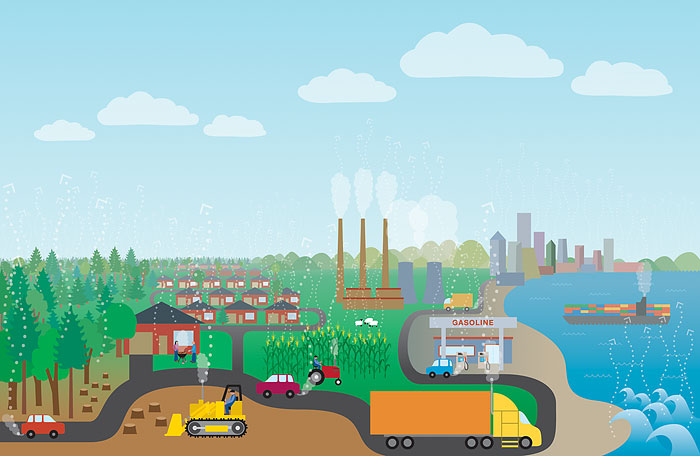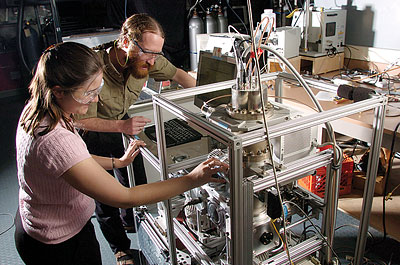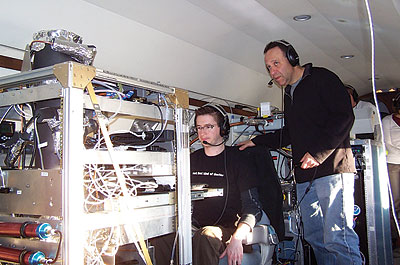
Air Apparent
The Earth’s atmosphere is full of billions upon billions of particles that can’t be seen by the naked eye. They adversely affect our health and impact our climate, and they pose a serious challenge to scientists trying to study them. Carnegie Mellon chemists are unraveling their life stories.
by Amy Pavlak

The images of Pittsburgh during the late 1800s are iconic— plumes of black smoke belched from steel mills. A thick, dark haze blanketed the city. The air was so saturated with soot that particles dropped out of the sky, coated buildings and worked their way into residents’ lungs.
Today, Pittsburgh’s air is no longer inundated with soot. But Pittsburgh’s air—as well as the air over other urban areas like Mexico City or Beijing, and even the air over pristine pine forests and vast stretches of ocean—is still chock-full of particles. There may be thousands of particles per cubic centimeter in the air we breathe. And they’re not as straightforward as a speck of soot. Most of the particles in our air are anonymous mixtures of thousands of molecules.
“We don’t know where a specific particle comes from, how much comes from trees and cars and fires, or the way they are chemically transformed in the atmosphere,” said Neil Donahue, professor of chemistry and chemical engineering, and director of Carnegie Mellon’s Center for Atmospheric Particle Studies (CAPS). “It’s a vibrant, messy, dirty soup of things.”
And Donahue is in the thick of it. A meteorologist by training, he has spent more than 20 years investigating how organic compounds and atmospheric particles called aerosols are chemically transformed over time. The thought is that if we can understand what the particles are made of, we can get a better handle on how they affect our health and impact our climate.
Aerosols, tiny liquid or solid particles suspended in the atmosphere, come from hundreds of different types of sources across the globe. Volcanoes spew clouds of gaseous ash when they erupt. Desert winds kick up mineral dust, and ocean spray releases sea salt into the air. Cars, trucks, power plants, wood fires and even barbeque pits emit an array of organic compounds into the air. They are very small, from a few nanometers to several tens of micrometers in size, but they have a big impact. It is clear that human activity has greatly increased aerosol levels, but by exactly how much remains uncertain.
In the United States each year, 50,000 premature deaths from heart and lung disease are attributable to excess concentrations of aerosols, especially particles less than 2.5 micrometers in diameter. Aerosols also contribute to global climate change by scattering and absorbing sunlight and participating in cloud formation, which influence the heating and cooling of the planet.
“Aerosols have a very significant role in the climate cycle, but it’s a role that is not especially well understood,” said Donahue. “The atmosphere is a highly oxidizing, highly reactive place, which means that aerosols get transformed really rapidly. And that transformation is going to change the way aerosols affect clouds—and the way they affect health.”
Tracking Aerosols’ Chemical Transformation

Neil Donahue and alumna Gabriella Engelhart Farnham (E’10) work on an Aerosol Mass Spectrometer in Carnegie Mellon’s Air Quality Lab.
When he’s not studying aerosols in the Amazon or a forest in Finland, you can find Donahue in the Doherty Hall’s Air Quality Lab, churning out biomass smoke and diesel fumes. In the controlled environment of the laboratory, he can generate aerosols of his choosing, put them into a “fake atmosphere” and study how the particles’ physical and chemical properties change over minutes or hours.
Organic aerosols like those emitted by a semi-truck’s tailpipe or a swath of agricultural burning react quickly with oxygen and other gases in the atmosphere. The aerosols undergo a process called oxidation—the same chemical process that turns iron to rust when it’s exposed to air and water. Just as rust has different chemical properties than iron, so too do organic aerosols once they’ve been oxidized. Most notably, they develop a lower vapor pressure that drives them to condense, making them more likely to stick to other particles floating around in the atmosphere. They also become more water soluble, like the difference between wax and sugar.
“One of the many things that make the science of fine particles interesting is that they aren’t molecules. They’re collections of goop,” said Donahue.
More than half of the goop on any given particle is made up of organic compounds. Donahue focuses his research efforts on exploring how those organics behave in the atmosphere, a particularly challenging endeavor because the organic material on the particles is very chemically reactive.
Until recently scientists assumed that organic aerosols didn’t change much once they were emitted into the atmosphere. They thought that a piece of soot escaping from a chimney in Pittsburgh was pretty much the same when it landed in Florida. Scientists, including Donahue and his colleagues in CAPS, have found that this isn’t the case.
In the March 2007 issue of Science, Mechanical Engineering Professor Allen Robinson, Donahue and other CAPS colleagues reported laboratory work and the initial theory describing how chemical processes that occur after aerosols are emitted into the atmosphere change aerosols’ chemical and physical properties and create new particles.
“Our contribution to the field has been to realize exactly how interesting and dynamic the behavior of these organics is and to begin to develop ways that we can actually grapple with it,” Donahue said.
Recently Donahue developed a theoretical framework that tracks two properties that evolve as organic aerosols make their way through the atmosphere—volatility, or the tendency to evaporate, and the oxygen to carbon ratio, which is an indicator of how much oxygen is building up on particles. Donahue’s framework is based on laboratory and field data gathered from dozens of groups working around the world, including an air quality study done in Pittsburgh. The work was published in the January 2009 issue of Science with lead author Jose-Luis Jimenez at the University of Colorado at Boulder and 60 international colleagues.
Researchers around the world are already using Donahue’s framework to guide their research efforts, helping to understand experimental data and developing more accurate computer models of aerosol behavior. A recent paper in the March 11, 2011 issue of Science showed that this theory explains the formation of aerosols in the air over the Deepwater Horizon oil spill in the Gulf of Mexico.
One Particle at a Time

Ryan Sullivan (seated) and Paul DeMott, a research scientist at Colorado State University, on board the Department of Energy’s G-1 Research Aircraft.
Getting a handle on how the atmosphere transforms organic aerosols is extremely challenging given aerosols’ immense chemical complexity.
“The piece of graphitic black soot that came out of a bus’s tailpipe or the droplet of fat that came off of a barbeque pit is a little thing. It’s 10 nanometers across. But after it travels thousands of miles through the atmosphere it ends up with 80–100 nanometers of this goop on top of it,” Donahue explained.
While those layers of goop provide chemical clues as to how the organic aerosol evolved, they also bury the original particle that was emitted, making it difficult to pinpoint its source. Knowing the origin and fate of an organic aerosol is key to helping regulatory agencies devise ways to improve air quality by managing aerosol production at the source.
“Measuring these really small particles, especially at the individual particle level—which I feel is what we need to do if we want to truly understand particles— is pretty difficult,” said Ryan Sullivan, recently appointed assistant professor of chemistry and mechanical engineering, and CAPS’s newest faculty member. “They are very dynamic, they are very tiny, there’s not a lot of mass in each one, and they are constantly changing.”
To tackle some of these challenges, Sullivan plans to modify a single particle mass spectrometer (SPMS), which detects the chemical composition of individual particles. His modifications to the existing technique aim to make the data from each individual particle more reproducible and quantitative so that he can determine more precisely what makes up each particle. He also plans to make the SPMS aircraft deployable to capture data in real time as the instrument pulls in air from outside a plane.
“Real time is really important when you are doing field measurements, especially from an aircraft because things are flying by you and changing very quickly,” said Sullivan, who has flown through pollution plumes and clouds to gather in situ data.
In addition to the SPMS, Sullivan is developing another technique to study single particles. Called an optical tweezers particle trap, it uses a tightly focused laser beam to trap a particle and hold it for hours. Once a single particle is trapped, Sullivan can expose it to different gases or varying levels of humidity to observe how the particle responds.
Getting a firmer grasp on single-particle-level detail is key to developing models that accurately predict how particles behave in the atmosphere and how they interact with their environment. According to Sullivan, these sorts of details aren’t incorporated into existing models because scientists don’t have such a deep understanding of particle behavior yet.
As Sullivan, Donahue and their CAPS colleagues gather experimental evidence and develop theoretical frameworks to predict the sources and evolution of aerosols in the atmosphere, they also apprise the Environmental Protection Agency, state and local governments and researchers who investigate the health effects associated with air pollution of their findings. New research that helps to more accurately predict aerosols’ impacts on health and climate will enable such regulatory agencies to make more effective decisions as they consider strategies for improving air quality.
So perhaps Pittsburghers and billions of people around the globe can breathe a sigh of relief. At Carnegie Mellon, CAPS faculty members are figuring out what’s actually in the air we breathe.